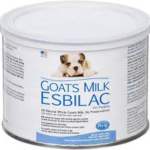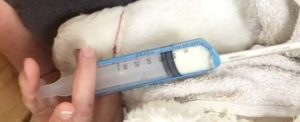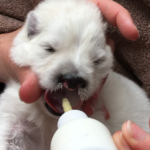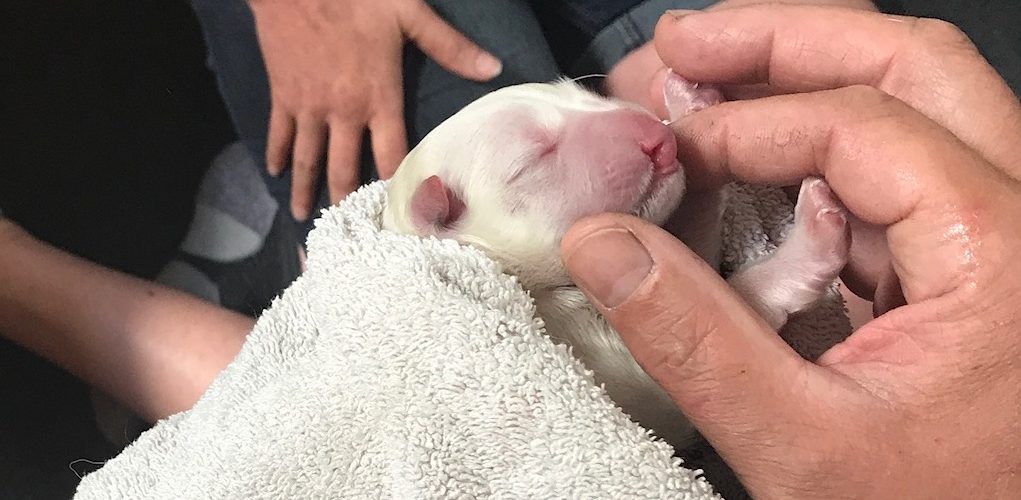Preparation is key in case of complications
Rose Valley White Shepherds received multiple litters over the last 5 years. At leas ones a year we’ll have puppies. Out of all these healthy puppies there can also be complications. A puppy can be stuck for too long and needs a bit of rubbing to start breeding or can be born tail first. Sometimes is more seriously. Out of the 30 puppies that were born under our careful watch, 2 puppies were born with complications. Happy to say that even these puppies are well taken care of!
However, preparation is key especially in case of complications! Our C-litter counted 9 puppies. Clifford was the first born. This blog is all about him since he was born with a cleft lip and cleft palate!
The first 7 days are crucial to survive a cleft lip and cleft palate. When you’re expecting a litter, you want everything to go smooth. No stress and no complications. And we like to prepare! Having a medical kit ready, phone number vet under speed dial, puppy pen in the room for a couple days, our little booklet ready to write down the specifics of each puppy and of course the colourful collars are ready.
The first 7 days
We noticed with the first born, we needed to act! The sack didn’t want to open and when opened Clifford’s breathing had a gurgle – fluid had entered his lungs. When my husband inspected him he saw his thrive to survive. A will to live. We started to fight for him. Rubbing his back gave him the opportunity to release the fluid, which was great. Lots of emotions went through us all. First we were shocked, then extremely worried and finally we decided to fight for him and love him unconditionally. The first 7 days all puppies need to be watched, cared for and supervised. we knew that the first 7 days would be crucial for Clifford!
 In an effort to give Clifford the advantage of the first milk, we sucked up Nita’s colostrum with a bulb syringe and gave it to him. Tiny bit – by – tiny bit. Recommend is 2 days of mommy milk but with 8 other puppies to feed we couldn’t catch enough to also feed Clifford. Instead of that we choose replacement milk. At first we PetAg’s Esbilac Milk replacer for puppies newborn to 6 weeks. Based on Skim Milk. It didn’t go well.
In an effort to give Clifford the advantage of the first milk, we sucked up Nita’s colostrum with a bulb syringe and gave it to him. Tiny bit – by – tiny bit. Recommend is 2 days of mommy milk but with 8 other puppies to feed we couldn’t catch enough to also feed Clifford. Instead of that we choose replacement milk. At first we PetAg’s Esbilac Milk replacer for puppies newborn to 6 weeks. Based on Skim Milk. It didn’t go well.
It’s not that the milk isn’t good but it looked like Clifford had an allergic reaction to it. We tried for 3 days to feed him with a milk bottle and a syringe.  Then we went over to the PetAG Esbilac Goat Milk Replacer. And that was a huge success. He started to gain weight and we even replaced the 1ml syringe for a large 30ml syringe for him to drink his first 10ml!
Then we went over to the PetAG Esbilac Goat Milk Replacer. And that was a huge success. He started to gain weight and we even replaced the 1ml syringe for a large 30ml syringe for him to drink his first 10ml!
How Nita Reacted
Nita knew there was something wrong. Luckily she didn’t abandoned him, you could tell she cared for him but he wasn’t allowed near her nipples. So, I fed Clifford in her pen for her to keep an eye on him and after every feeding I presented Clifford to her for her to clean him and to stimulate his bowel. That worked out well.
The impact on your life
Making the decision to go for him, will have a huge impact on your life. You have to give your full dedication to your puppy. If not, it will starve to death. Meaning: You’ve got to give your full commitment! Feed every 2 hours in the first week and every 3 hours in the next weeks till at least 3 months.
We understood and made the decision to go-for-him!
Vet
On Sunday we contacted our vet Dr. Noah Oz from Rose Valley Veterinary Hospital and consulted her on what to do. We decided to show her the puppy the next day. And so we did. We ‘kidnapped’ it under Nita’s nose and fortunately for us she didn’t notice. lol
Diagnose: 20% survival rate the first 7 days because of the risk of pneumonia… Since food is likely to go in his lungs.
Emotional roller coaster
The first 3 days were an emotional roller coaster. Dealing with the diagnoses from our Vet, changing the milk replacer from skim milk to goat’s milk and the way to feed Clifford (bottle to syringe) was extremely overwhelming. To be honest, I was in tears for 3 days. Everything in me wanted him to survive and would do everything for it. Therefore, I made a executive family decision 😉 to manage all our stress levels. I wanna to be the only one giving him the care he needed. Just to protect our daughters if something would go wrong and for my husband to make good full nights, so he could function well during the day.
How much do you have to feed
 How much a puppy should eat obviously depends on the weight, size, and breed of your dog. But a good rule of thumb is that your puppy should eat about 25-35 milliliters of formula for every 3.5 ounces of body weight each day. Divide that number by the number of feedings per day and that will give you the correct amount of formula to provide at each feeding.
How much a puppy should eat obviously depends on the weight, size, and breed of your dog. But a good rule of thumb is that your puppy should eat about 25-35 milliliters of formula for every 3.5 ounces of body weight each day. Divide that number by the number of feedings per day and that will give you the correct amount of formula to provide at each feeding.
Or way simpler one website used a simple rule: feed 1cc per 1 ounce body weight. If your puppy weighs 3 ounces, feed 3 cc’s every three hours.
In my case, Clifford was weighing 18lb. The first day I was feeding 15 to 20 ml per meal. But the next 2 days where times only 3 ml went in every hour…. replacing the milk and a better feeding rhythm gave a better result, and we were back to 25ml per meal on day 4.
How we fed Clifford
 We started with a bottle. Not knowing about his allergic reaction to the skim milk replacer we went over to a 1 cc syringe. But 15 times refilling the syringe was a very unhandy thing. We went over to a 30cc syringe and I extended the tip of the syringe with the 1 cc syringe to fit his tiny mouth. On the photo you can see the whole construction. Even bigger then Clifford!! Then I cut the 1cc syringe at 0.4cc to better handle the total length of the syringe. Sounds like a struggle and I can assure it was a struggle…
We started with a bottle. Not knowing about his allergic reaction to the skim milk replacer we went over to a 1 cc syringe. But 15 times refilling the syringe was a very unhandy thing. We went over to a 30cc syringe and I extended the tip of the syringe with the 1 cc syringe to fit his tiny mouth. On the photo you can see the whole construction. Even bigger then Clifford!! Then I cut the 1cc syringe at 0.4cc to better handle the total length of the syringe. Sounds like a struggle and I can assure it was a struggle…
After a 2 weeks of trial and error, we re-introduced the bottle again to Clifford. A bigger hole in the long narrow nipple to ‘squeeze’ the milk on his tongue did the trick. The photo on the right you can see how that looks like. Clifford is 2 weeks old on this photo…
Challenges
We encountered a couple challenges.
* Kind of puppy milk replacer – Skim Milk or Goat Milk
* How to feed – bottle feeding (what nipple to use) or syringe (what size)
* Syringe issues – couldn’t stand hot water (shrieked the tube but not the plunger) and was to big and hard to use and clean.
* How much to feed – although there are guidelines, it’s not always works like that. When not meeting the expecting amount it gives a lot of stress.





